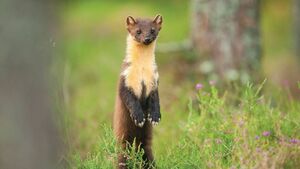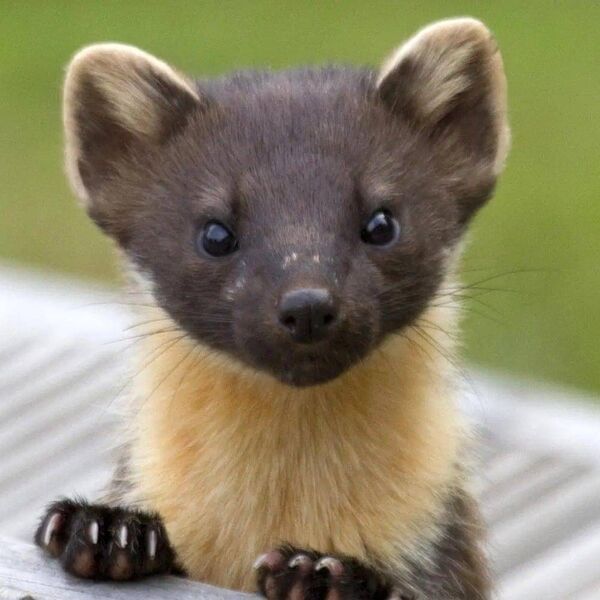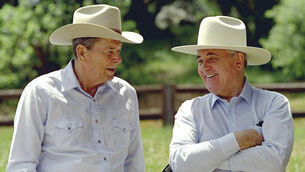The Pine Marten – Our friend or our foe?

Following the introduction of legal protection in 1976, the pine marten population has built up slowly, including in the west and north-west.
There was a time in the Ox Mountain region when the Pine Marten was unheard of, its Irish home largely confined to the woods around Killarney and the worn limestone walls of the Burren in County Clare. However, the pine marten is here now and, it would appear, is here to stay.
It seems likely that the increase of afforestation in recent times, as well as the lack of any natural predator, has led to a spread in the hunting grounds of our new chocolate and cream friend. However, some would argue that this boyo is more foe than friend.
Mustelids are a group of creatures that include the weasel, stoat, mink and polecat. The European pine marten (Martes martes) is also a mustelid and one that is native to – and widespread – in most of Europe. The Vincent Wildlife Trust, a mammal conservation charity, provides some background on the decline and resurgence of the pine marten in Ireland.
“The pine marten is native to Ireland and is one of our rarest mammals. Once common throughout the country, by the 20th century this species had become extinct from the majority of the island, surviving only in a few isolated and fragmented populations. This decline was the result of hunting of martens for their fur, loss of habitat and both direct and indirect poisoning and persecution. Following the introduction of legal protection in 1976, numbers built up slowly in its refuges in the west and south. From there, facilitated to some extent by the expansion of forestry, it has spread into the midlands and the north-west.”
The marten, as its Irish name (cat crainn) suggests, spends most of its time in trees. It is the only mustelid with semi-retractable claws. This enables them to lead a life of climbing or running on tree branches. They are mainly active at night – but more about that later. They have small, rounded, highly sensitive ears and sharp teeth adapted for eating small mammals, birds, insects, frogs, and carrion. They have also been known to eat berries, fruits, birds' eggs, nuts and honey. The pine marten is territorial; you will only ever have one breeding pair in your wood’s neck.
The pine marten has been present in Ireland for thousands of years. Niall MacCoitir in his book, , makes many references to the pine marten, including possible links to place names such as Carrickacat (Carraig an Chait – rock of the cat) in Co. Mayo.
MacCoitir also describes references to the pine marten in stories about Fionn MacCumhaill, the mythical hunter-warrior, and his band of Irish warriors known as the Fianna. In fact, Fionn’s first heroic act, as an infant, involves a pine marten that had approached the camp where Fionn lay sleeping, attracted by the smell of wild pig meat. Fionn strangled the marten and then wore its pelt as a blanket. Queen Meadhbh of Connacht is reputed to have worm the pelt of a pine marten around her shoulders.
The recovery of the pine marten in Ireland has been linked with them reducing the population of invasive grey squirrels. Where the range of the expanding pine marten population met that of the grey squirrel, the population of the grey squirrels quickly fell and encouragingly, the population of the red squirrel recovered. On the face of it, this seemed like a win/win situation. The trouble is that the pine marten doesn’t just prey on grey squirrels, it preys on a lot of other stuff as well.

My own first experience of a pine marten was when one arrived in the dead of night and killed every living thing in my hen house. More and more poultry keepers are encountering that deafening silence as they approach their hen house of a morning. It is that stillness that tells you, even before you open the door, that all within is dead. The pine marten will revisit the scene of his crime and that is how you know that he is the one responsible.
And so, the debate begins; is the pine marten a friend or a foe? There is no doubt that their cull of the grey squirrel a good thing. The grey squirrel is invasive and preys on our native red squirrel. As tree animals, they destroy countless wild bird nests and newly hatched fledglings. The larger their population becomes, the more destruction we will encounter. However, they are territorial and so overpopulation, when full population is reached, will not be a problem.
Many fanciers who experience a pine martin massacre in their hen coop are presented with a pile of slaughtered hens. It seems the pine marten just kills for fun; such a small animal couldn’t possibly consume so much bounty – not even by returning a day later for second helpings. Despite all this, it is safe to say that the pine marten does NOT kill for fun. Thinking so, is an emotional human interpretation of an animal situation. What happens is that the pine marten sees the whole flock as one beast and he will continue to do what he does best until his battle is won, until there is silence. In a hen house of twelve birds, that means only one thing.
Our anger therefore needs to be tempered and best directed to achieve lasting results that does not involve doing to the pine marten what pine marten did to your flock of hens. Our weakness is that we have a houseful of defenceless hens, often kept in a way that allows the wily pine marten easy access. A person with only the most basic knowledge of pine martens would quickly point out that we have sown the seeds of an inevitable disaster. So, is there a way to have domestic poultry, and all the joy that goes with them, in a world where pine marten numbers are growing? The answer, happily for all parties concerned, is… yes!
The old saying, ‘good fences make good neighbours’ fits well here. Pine martens only strike at night. By way of protection, what keeps your hens in will not necessarily keep a pine marten out. If hen houses are properly closed and fastidiously secured, all should be well.
To guide us in this regard, the Vincent Wildlife Trust and the National Parks and Wildlife Service have jointly produced a leaflet ‘How to exclude pine martens from game and poultry pens’. The leaflet provides practical steps that can be taken to protect game and domestic fowl from pine martens. Copies of this leaflet are downloadable from the website https://mammals-in-ireland.ie. Pine martens are protected in Ireland by both national and international legislation. Under the Irish Wildlife Acts it is an offence, except under licence, to capture or kill a pine marten, or to destroy or disturb its resting places.
A pine marten will gain access through the smallest hole in your armour so be painstaking in your work. A fine metal mesh over every conceivable opening is the only way. As the pine marten population continues to grow, your attention to detail becomes more critical. Your poultry need to be perfectly secure and if they are, you have greatly enhanced your chances of never hearing that eerie silence as you lift the latch on your hen house door.






